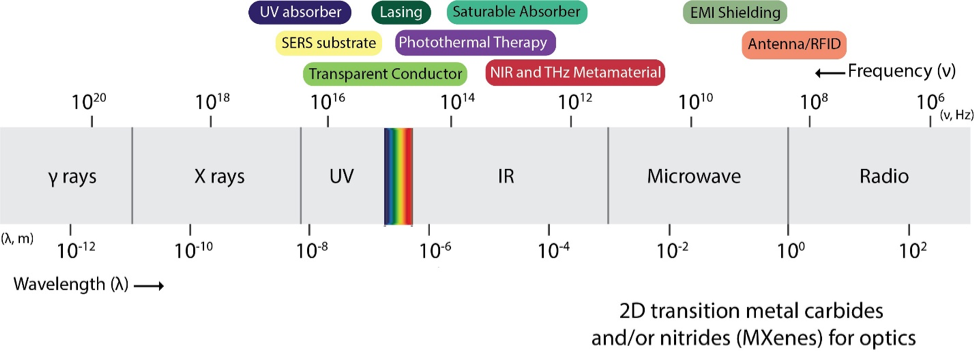2D
MXenes provide new physics and phenomena which may not be available in
conventional materials, however it is our job to discover them. Unlocking these
properties allows for similar (or better) performance at much lower material
thickness, permits the control of light, or it may reveal ultrasensitive devices.
While we are just scratching the surface of potential applications for this
diverse family, MXenes have been explored in a diverse set of electronic and
optical applications, and some are listed below.
A
recent review of optical and electronic applications of MXenes: Hantanasirisakul,
K. and Gogotsi, Y., 2018. Electronic and optical properties of 2Dtransition metal carbides and nitrides (MXenes). Advanced Materials, 30 (52),
1804779.


Wireless communication and shielding: What if
all electromagnetic frequencies were visible to the human eye? We could
see a radio station broadcasting, potentially redirect a text message to
another phone, or maybe block electronic pollution from crowding the air. Turns
out these waves are ‘visible’ to some materials and can interact with them in
different ways. Having the ability to block or transmit electromagnetic
(EM) waves becomes critical when attempting to protect electronic equipment or
communicate through an antenna, and both can be achieved with MXenes.
Conventional materials used in these applications includes metals, such as
copper, aluminum, or gold, and carbon materials, such as carbon nanotubes or carbon
fiber composites. When comparing to conventional materials, MXenes perform
similarly at much lower thicknesses, allowing for construction of thinner
antennas or EMI shields. Control over the material density has allowed for
tunable devices to be created with varying degrees of EM absorption or
reflection.
More
information and related references:
Shahzad,
F., Alhabeb, M., Hatter, C.B., Anasori, B., Hong, S.M., Koo, C.M. and Gogotsi,
Y., 2016. Electromagnetic interference shielding with 2D transitionmetal carbides (MXenes). Science, 353 (6304), 1137-1140.
Sarycheva,
A., Polemi, A., Liu, Y., Dandekar, K., Anasori, B. and Gogotsi, Y., 2018.
2D titanium carbide (MXene) for wireless communication. Science Advances, 4 (9),
eaau0920.
Han,
M., Yin, X., Hantanasirisakul, K., Li, X., Iqbal, A., Hatter, C.B., Anasori,
B., Koo, C.M., Torita, T., Soda, Y. and Zhang, L., 2019. AnisotropicMXene Aerogels with a Mechanically Tunable Ratio of Electromagnetic WaveReflection to Absorption. Advanced Optical Materials, 7 (10), 1900267.

Light Control: Ever consider what a two way
mirror or an anti-reflective coating is made from? How can we control light to
perform in the way we wish? Beyond simple transmission of light, MXenes
have been shown to exhibit saturable absorption properties in the near infrared
(near-IR), meaning the absorption of light decreases (transmission of light
increases) with increasing light intensity. This property was used to create a
photonic diode with fullerenes (C60), which performed by
transmitting light differently when viewed in the forward and reverse
directions. Saturable absorption properties can be applied in applications such
as lasers and tuned when we take advantage of disks/pillar-like nanostructures
at near-IR or terahertz frequencies.
More
information and related references:
Dong,
Y., Chertopalov, S., Maleski, K., Anasori, B., Hu, L., Bhattacharya, S., Rao,
A.M., Gogotsi, Y., Mochalin, V.N. and Podila, R., 2018. Saturable
absorption in 2D Ti3C2 MXene thin films for passive
photonic diodes. Advanced Materials, 30 (10), 1705714.
Chaudhuri,
K., Alhabeb, M., Wang, Z., Shalaev, V.M., Gogotsi, Y. and Boltasseva, A., 2018.
Highly broadband absorber using plasmonic titanium carbide (MXene). ACS
Photonics, 5 (3), 1115-1122.
Choi,
G., Shahzad, F., Bahk, Y.M., Jhon, Y.M., Park, H., Alhabeb, M., Anasori, B.,
Kim, D.S., Koo, C.M., Gogotsi, Y. and Seo, M., 2018. Enhanced TerahertzShielding of MXenes with Nano‐Metamaterials. Advanced Optical
Materials, 6 (5), 1701076.

Transparent Conductors: What if every window
harvested solar energy, was able to control the room temperature by adjusting
the window color, and did it all without sacrificing visibility? In
the visible and near-IR regimes, MXenes transmit EM waves and the quantity of transmission
is directly dependent on the MXene composition and thickness of material
present. This permits MXenes to be used as transparent conductors in energy
storage and display applications. Furthermore, the color and transparency of
the device reversibly changes with applied potential allowing for
electrochromic devices (and maybe windows!) to be fabricated with different
colors.
More information and related references:
Dillon,
A.D., Ghidiu, M.J., Krick, A.L., Griggs, J., May, S.J., Gogotsi, Y., Barsoum,
M.W. and Fafarman, A.T., 2016. Highly conductive optical qualitysolution‐processed films of 2D titanium carbide. Advanced Functional
Materials, 26 (23), 4162-4168.
Salles,
P., Pinto, D., Hantanasirisakul, K., Maleski, K., Shuck, C.E. and Gogotsi, Y., 2019.
Electrochromic Effect in Titanium Carbide MXene Thin Films Produced byDip‐Coating. Advanced Functional Materials, 29 (17), 1809223.

Sensors: Imagine your cell phone has an app
that operates like your dog’s nose: able to distinguish thousands of smells and
simultaneously identify them to you? MXene gas sensors exhibited a very low
limit of detection of 50–100 parts per billion (ppb) for volatile organic
compounds gases (such as ethanol). The extremely low noise led to a
signal-to-noise ratio 2 orders of magnitude higher than that of other 2D
materials, surpassing the best sensors known. Furthermore, because MXenes have
been considered plasmonic materials, surface enhanced Raman spectroscopy (SERS)
applications have been explored, where signal enhancement of dyes or molecules
occurs. The combination of chemical sensitivity and interaction with light
allows for chemical and light-induced sensors to be fabricated.
More
information and related references:
Sarycheva,
A., Makaryan, T., Maleski, K., Satheeshkumar, E., Melikyan, A., Minassian, H.,
Yoshimura, M. and Gogotsi, Y., 2017. Two-dimensional titanium carbide(MXene) as surface-enhanced Raman scattering substrate. The Journal of
Physical Chemistry C, 121 (36), 19983-19988.
Kim,
S.J., Koh, H.J., Ren, C.E., Kwon, O., Maleski, K., Cho, S.Y., Anasori, B., Kim,
C.K., Choi, Y.K., Kim, J. and Gogotsi, Y., 2018. Metallic Ti3C2Tx
MXene gas sensors with ultrahigh signal-to-noise ratio. ACS Nano, 12 (2),
986-993.